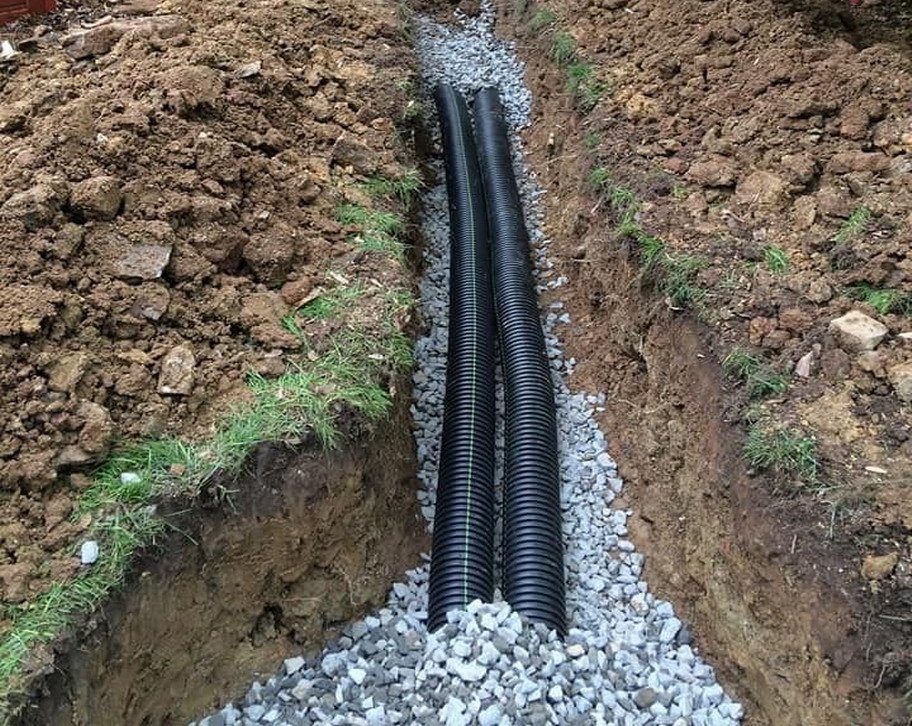If your yard turns muddy every time it rains, a French drain might be the solution you’ve been missing. Here’s how this system actually works beneath your feet. Like a silent guardian, it prevents your yard from becoming a swampy mess and protects your home’s foundation from costly water damage.
A French drain is essentially an underground water management system that uses gravity to redirect excess water away from problem areas. By combining a gravel-filled trench with a perforated pipe, it creates a natural pathway for water to flow away from your property, keeping your yard dry and usable year-round.

Having water problems in your yard? A French drain might be just what you need. This clever drainage solution has been helping homeowners manage excess water since the 1800s, named after Henry Flagg French who first wrote about this system.
French drain work as your yard’s underground water highway. It’s a smart drainage system that collects and redirects water away from trouble spots, keeping your yard from turning into a soggy mess and protecting your home’s foundation from water damage.
The magic happens through three main parts working together.
First, there’s a trench that’s dug into your yard. Inside this trench sits a perforated pipe that’s surrounded by gravel. This combination allows water to seep in and flow away naturally, making it one of the most effective yard drainage systems you can install.
Standing water in the yard isn’t just unsightly, it can lead to serious drainage issues. That’s where French drains shine, offering a reliable drainage solution that keeps your outdoor space dry and usable.
The process of french drains working is actually quite simple, it creates an underground pathway that lets water flow naturally from wet areas to drier ones, much like a miniature river beneath your lawn.
When it rains, or when groundwater rises, the excess water seeps through the soil and enters the drainage trench. This trench, filled with gravel, acts like a filter that helps water flow freely toward the perforated pipe at the bottom.
Here’s the clever part, the French drain work relies on gravity to do its job. The drainage pipe is installed with a gentle slope, typically dropping about an inch for every 10 feet. This slight tilt helps redirect water away from your foundation walls and prevents standing water in your yard.
The perforated drainage pipe, surrounded by gravel or rock, collects this water and guides it to a suitable location for water drainage, like a drainage ditch or street. Think of it as giving water an easy path to follow, keeping your yard dry and your foundation safe.
When you install a French drain, the trench is your foundation. You’ll need to dig a channel that’s between 18 and 24 inches deep and 6 to 12 inches wide. This might seem like a lot of digging, but proper sizing ensures your drainage system works effectively. Remember, the trench needs a consistent downward slope to help water flow naturally away from your property.
The heart of your French drain work is the perforated pipe, typically a 4-inch diameter pipe designed specifically for drainage. Its like an underground highway for excess water, with tiny holes that allow groundwater to enter and flow freely. These holes are strategically placed to maximize water collection while maintaining the pipe’s structural strength.
Gravel isn’t just filler, it’s an important part of your French drain system. The gravel layer acts like a natural filter, preventing soil and debris from clogging your drainage pipe while allowing water to seep through easily. Plus, it helps anchor your perforated pipe in place and maintains the structural integrity of your yard drainage solution.
Regular inspection of your French drain system is most important thing for optimal performance.
Check the perforated pipe periodically for any signs of clogging from soil, roots, or debris that could compromise its effectiveness.
Maintaining the drainage system includes clearing debris from the gravel layer and ensuring the discharge point remains free from obstruction. This prevents water from backing up and helps maintain proper water flow throughout the system.
To ensure your French drain continues functioning effectively for years to come, establish a routine maintenance schedule.
Regular upkeep helps identify potential issues early and prevents costly repairs or system failures in the future.
When it comes to keeping your yard dry and damage-free, Atlantic Hardscape and Concrete is the name homeowners in Fredericton trust most. Our team specializes in designing and installing reliable French drain systems that protect your property from excess water and erosion.
Whether you’re dealing with pooling rainwater or foundation drainage issues, we create a customized water management system in Fredericton, NB that actually works. Let our experienced crew handle your project from start to finish, so you can enjoy a clean, dry, and worry-free yard year-round.
Yes, French drains can clog over time as dirt, roots, and debris accumulate in the perforated pipe and gravel layers, potentially blocking water flow and reducing drainage efficiency. To prevent these blockages, using landscaping fabric during installation and performing periodic maintenance are crucial steps in keeping the drain system functional. Regular inspection and clearing of the drainage system will help maintain its effectiveness and prevent potential water backup or drainage problems.
Often improving yard slope (grading) and ensuring water flows away from the house or high-risk areas is the first step. If slope alone doesn’t solve the pooling, a French drain may then be needed.
If your yard stays soggy even after installing a French drain, the problem is often due to dense or clay soil, no proper outlet or insufficient slope, or wrong materials/incorrect installation.
GET STARTED
Your dream space is within reach as we work together from detailed 3-D designs to the final custom build. Our process is both professional and exciting, and we look forward to taking this journey with you.
Contact
34 Jackstraw Court, Fredericton, NB, Canada, New Brunswick